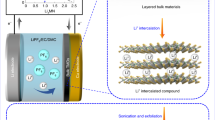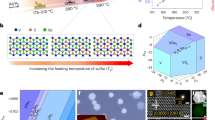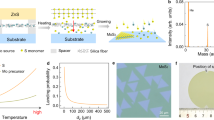Abstract
Functionalizing the surfaces of transition metal dichalcogenide (TMD) nanosheets with noble metals is important for electrically contacting them to devices, as well as improving their catalytic and sensing capabilities. Solution-phase deposition provides a scalable approach to the creation of metal–TMD hybrid systems, but controlling such processes remains challenging. Here we elucidate the different pathways by which gold and silver deposit at room temperature onto colloidal 1T-WS2, 2H-WS2, 2H-MoSe2, 2H-WSe2, 1T′-MoTe2 and Td-WTe2 few-layer nanostructures to produce several distinct classes of 0D–2D and 2D–2D metal–TMD hybrids. Uniform gold nanoparticles form on all of the TMDs. By contrast, silver deposits as nanoparticles with a bimodal size distribution on the disulfides and diselenides, and as atomically thin layers on the ditellurides. The various sizes and morphologies of these surface-bound metal species arise from the relative strengths of the interfacial metal–chalcogen bonds during the reduction of Au3+ or Ag+ by the TMDs.
This is a preview of subscription content, access via your institution
Access options
Access Nature and 54 other Nature Portfolio journals
Get Nature+, our best-value online-access subscription
$29.99 / 30 days
cancel any time
Subscribe to this journal
Receive 12 print issues and online access
$259.00 per year
only $21.58 per issue
Buy this article
- Purchase on Springer Link
- Instant access to full article PDF
Prices may be subject to local taxes which are calculated during checkout






Similar content being viewed by others
Data availability
All of the data that support the findings of this study are available within the Article and its Supplementary Information, and/or from the corresponding author on reasonable request.
References
Wang, Q. H., Kalantar-Zadeh, K., Kis, A., Coleman, J. N. & Strano, M. S. Electronics and optoelectronics of two-dimensional transition metal dichalcogenides. Nat. Nanotechnol. 7, 699–712 (2012).
Lv, R. et al. Transition metal dichalcogenides and beyond: synthesis, properties, and applications of single- and few-layer nanosheets. Acc. Chem. Res. 48, 56–64 (2015).
Jaramillo, T. F. et al. Identification of active edge sites for electrochemical H2 evolution from MoS2 nanocatalysts. Science 317, 100–102 (2007).
Ali, M. N. et al. Large, non-saturating magnetoresistance in WTe2. Nature 514, 205–208 (2014).
Gong, Y. et al. Vertical and in-plane heterostructures from WS2/MoS2 monolayers. Nat. Mater. 13, 1135–1142 (2014).
Voiry, D. et al. Covalent functionalization of monolayered transition metal dichalcogenides by phase engineering. Nat. Chem. 7, 45–49 (2014).
Kang, Y. et al. Plasmonic hot electron induced structural phase transition in a MoS2 monolayer. Adv. Mater. 26, 6467–6471 (2014).
Chen, J. et al. Edge epitaxy of two-dimensional MoSe2 and MoS2 nanosheets on one-dimensional nanowires. J. Am. Chem. Soc. 139, 8653–8660 (2017).
Kang, D.-H. et al. An ultrahigh-performance photodetector based on a perovskite-transition-metal-dichalcogenide hybrid structure. Adv. Mater. 28, 7799–7806 (2016).
Chhowalla, M. et al. The chemistry of two-dimensional layered transition metal dichalcogenide nanosheets. Nat. Chem. 5, 263–275 (2013).
Li, H. et al. Synergetic interaction between neighbouring platinum monomers in CO2 hydrogenation. Nat. Nanotechnol. 13, 411–417 (2018).
Huang, X. et al. Solution-phase epitaxial growth of noble metal nanostructures on dispersible single-layer molybdenum disulfide nanosheets. Nat. Commun. 4, 1444 (2013).
Liu, Y. et al. Approaching the Schottky–Mott limit in van der Waals metal-semiconductor junctions. Nature 557, 696–700 (2018).
Popov, I., Seifert, G. & Tománek, D. Designing electrical contacts to MoS2 monolayers: a computational study. Phys. Rev. Lett. 108, 156802 (2012).
Zhao, W. et al. Exciton–plasmon coupling and electromagnetically induced transparency in monolayer semiconductors hybridized with Ag nanoparticles. Adv. Mater. 28, 2709–2715 (2016).
Zheng, D. et al. Manipulating coherent plasmon–exciton interaction in a single silver nanorod on monolayer WSe2. Nano Lett. 17, 3809–3814 (2017).
Najmaei, S. et al. Plasmonic pumping of excitonic photoluminescence in hybrid MoS2–Au nanostructures. ACS Nano 8, 12682–12689 (2014).
Gong, C. et al. Metal contacts on physical vapor deposited monolayer MoS2. ACS Nano 7, 11350–11357 (2013).
Lei, S. et al. Surface functionalization of two-dimensional metal chalcogenides by lewis acid–base chemistry. Nat. Nanotechnol. 11, 465–471 (2016).
Son, D. et al. Colloidal synthesis of uniform-sized molybdenum disulfide nanosheets for wafer-scale flexible nonvolatile memory. Adv. Mater. 28, 9326–9332 (2016).
Mahler, B., Hoepfner, V., Liao, K. & Ozin, G. A. Colloidal synthesis of 1T-WS2 and 2H-WS2 nanosheets: applications for photocatalytic hydrogen evolution. J. Am. Chem. Soc. 136, 14121–14127 (2014).
Yoo, D., Kim, M., Jeong, S., Han, J. & Cheon, J. Chemical synthetic strategy for single-layer transition-metal chalcogenides. J. Am. Chem. Soc. 136, 14670–14673 (2014).
Jung, W. et al. Colloidal synthesis of single-layer MSe2 (M = Mo, W) nanosheets via anisotropic solution-phase growth approach. J. Am. Chem. Soc. 137, 7266–7269 (2015).
Sun, D., Feng, S., Terrones, M. & Schaak, R. E. Formation and interlayer decoupling of colloidal MoSe2 nanoflowers. Chem. Mater. 27, 3167–3175 (2015).
Sun, Y. et al. Low-temperature solution synthesis of few-layer 1T’-MoTe2 nanostructures exhibiting lattice compression. Angew. Chem. Int. Ed. 55, 2830–2834 (2016).
Sun, Y., Fujisawa, K., Terrones, M. & Schaak, R. E. Solution synthesis of few-layer WTe2 and MoxW1−xTe2 nanostructures. J. Mater. Chem. C 5, 11317–11323 (2017).
Sun, Y. et al. Low-temperature solution synthesis of transition metal dichalcogenide alloys with tunable optical properties. J. Am. Chem. Soc. 139, 11096–11105 (2017).
Kim, J., Byun, S., Smith, A. J., Yu, J. & Huang, J. Enhanced electrocatalytic properties of transition-metal dichalcogenides sheets by spontaneous gold nanoparticle decoration. J. Phys. Chem. Lett. 4, 1227–1232 (2013).
Yeh, Y.-T. et al. Light-emitting transition metal dichalcogenide monolayers under cellular digestion. Adv. Mater. 30, 1703321 (2018).
Raza, F. et al. Structuring Pd nanoparticles on 2H-WS2 nanosheets induces excellent photocatalytic activity for cross-coupling reactions under visible light. J. Am. Chem. Soc. 139, 14767–14774 (2017).
Huo, Z., Tsung, C., Huang, W., Zhang, X. & Yang, P. Sub-two nanometer single crystal Au nanowires. Nano Lett. 8, 2041–2044 (2008).
Peng, S. et al. A facile synthesis of monodisperse Au nanoparticles and their catalysis of CO oxidation. Nano Res. 1, 229–234 (2008).
Choi, H. C., Shim, M., Bangsaruntip, S. & Dai, H. Spontaneous reduction of metal ions on the sidewalls of carbon nanotubes. J. Am. Chem. Soc. 124, 9058–9059 (2002).
Zhou, W. et al. Intrinsic structural defects in monolayer molybdenum disulfide. Nano Lett. 13, 2615–2622 (2013).
Sun, Y. et al. Defect-mediated selective hydrogenation of nitroarenes on nanostructured WS2. Chem. Sci. 10, 10310–10317 (2019).
Ulman, A. Formation and structure of self-assembled monolayers. Chem. Rev. 96, 1533–1554 (1996).
Laibinis, P. E. et al. Comparison of the structures and wetting properties of self-assembled monolayers of n-alkanethiols on the coinage metal surfaces, copper, silver, and gold. J. Am. Chem. Soc. 113, 7152–7167 (1991).
Hebb, M. H. Electrical conductivity of silver sulfide. J. Chem. Phys. 20, 185–190 (1952).
Elliott, S. R. A unified mechanism for metal photodissolution in amorphous chalcogenide materials. J. Non-Cryst. Solids 130, 85–97 (1991).
Hodges, J. M., Morse, J. R., Williams, M. E. & Schaak, R. E. Microscopic investigation of chemoselectivity in Ag–Pt–Fe3O4 heterotrimer formation: mechanistic insights and implications for controlling high-order hybrid nanoparticle morphology. J. Am. Chem. Soc. 137, 15493–15500 (2015).
Ridelman, Y. et al. Metallic nanobowls by galvanic replacement reaction on heterodimeric nanoparticles. Small 8, 654–660 (2012).
Hla, S. W., Prodan, A. & van Midden, H. J. P. Atomistic stress fluctuation at surfaces and edges of epitaxially grown silver nanorods. Nano Lett. 4, 1221–1224 (2004).
Milenov, T. I. et al. Preliminary studies of the Raman spectra of Ag2Te and Ag5Te3. Opt. Quant. Electron. 46, 573–580 (2014).
Gaarenstroom, S. W. & Winograd, N. Initial and final state effects in the ESCA spectra of cadmium and silver oxides. J. Chem. Phys. 67, 3500–3506 (1977).
Rodriguez, J. A. & Goodman, D. W. Surface science studies of the electronic and chemical properties of bimetallic systems. J. Phys. Chem. 95, 4196–4206 (1991).
Hu, P. et al. Electronic metal–support interactions in single-atom catalysts. Angew. Chem. Int. Ed. 53, 3418–3421 (2014).
Miller, J. T. et al. The effect of gold particle size on the Au–Au bond distance and ractivity toward oxygen in supported catalysts. J. Catal. 240, 222–234 (2006).
Wei, H. et al. Selective hydrogenation of acrolein on supported silver catalysts: a kinetic study of particle size effects. J. Catal. 298, 18–26 (2013).
van der Lee, A. & de Boer, J. L. Redetermination of the structure of hessite, Ag2Te-iii. Acta Cryst. C 49, 1444–1446 (1993).
Dawson, W. & Bullett, D. Electronic structure and crystallography of MoTe2 and WTe2. J. Phys. C 20, 6159–6174 (1987).
Hla, S. W., Marinković, V. & Prodan, A. The growth of gold on (001) surfaces of α- and β-MoTe2. Surf. Sci. 356, 130–136 (1996).
Plieth, W. J. Electrochemical properties of small clusters of metal atoms and their role in the surface enhanced Raman scattering. J. Phys. Chem. 86, 3166–3170 (1982).
Tang, L. et al. Electrochemical stability of nanometer-scale Pt particles in acidic environments. J. Am. Chem. Soc. 132, 596–600 (2010).
Tauster, S. J., Fung, S. C., Baker, R. T. K. & Horsley, J. A. Strong interactions in supported-metal catalysts. Science 211, 1121–1125 (1981).
Wang, Y. et al. Van der Waals contacts between three-dimensional metals and two-dimensional semiconductors. Nature 568, 70–74 (2019).
Koch, C. T. Determination of Core Structure Periodicity and Point Defect Density along Dislocations. PhD thesis, Arizona State Univ. (2002).
Rehr, J. J., Kas, J. J., Vila, F. D., Prange, M. P. & Jorissen, K. Parameter-free calculations of X-ray spectra with FEFF9. Phys. Chem. Chem. Phys. 12, 5503 (2010).
Perdew, J. P. et al. Restoring the density-gradient expansion for exchange in solids and surfaces. Phys. Rev. Lett. 100, 136406 (2008).
Tran, F., Stelzl, J. & Blaha, P. Rungs 1 to 4 of DFT Jacob’s ladder: extensive test on the lattice constant, bulk modulus, and cohesive energy of solids. J. Chem. Phys. 144, 204120 (2016).
Elsasser, C. et al. Relativistic effects on ground state properties of 4d and 5d transition metals. J. Phys. Condens. Matter 2, 4371–4394 (1990).
Granatier, J., Lazar, P., Otyepka, M. & Hobza, P. The nature of the binding of Au, Ag, and Pd to benzene, coronene, and graphene: from benchmark CCSD(T) calculations to plane-wave DFT calculations. J. Chem. Theory Comput. 7, 3743–3755 (2011).
Acknowledgements
Y.S. and R.E.S. were supported by the US National Science Foundation grant DMR-1607135 for the initial synthesis of the TMD nanostructures and grant CHE-1707830 for the studies involving deposition of Au and Ag. Y.W. and V.H.C. acknowledge the National Science Foundation Materials Innovation Platform Two-Dimensional Crystal Consortium under grant no. DMR-1539916. J.Y.C.C. and C.F.H. were supported by funds from Penn State University. Y.S., K.F. and M.T. acknowledge support from the Air Force Office of Scientific Research (AFOSR) grant FA9550-18-1-0072. J.T.M. was supported by the National Science Foundation under Cooperative Agreement no. EEC‐1647722. V.H.C. and M.T. also acknowledge the Center for 2-Dimensional and Layered Materials at the Pennsylvania State University. Electron microscopy and XPS were performed at the Electron Microscopy Facility at the Materials Characterization Lab of the Penn State Materials Research Institute. Use of APS is supported by the US Department of Energy, Office of Science, and Office of Basic Energy Sciences under contract no. DE-AC02-06CH11357. MRCAT operations (beamline 10-BM) are supported by the Department of Energy and the MRCAT member institutions. We thank J. Katsoudas and J. Wright for the assistance during XAS experiments at the 10-BM beamline at the APS at Argonne National Laboratory. We also thank J. Grey and K. Wang for assistance with TEM characterization and J. Shallenberger for XPS acquisition and analysis.
Author information
Authors and Affiliations
Contributions
Y.S. carried out all the synthetic work and characterization by XRD, TEM, HAADF-STEM, STEM-EDS and Raman. Y.W. and V.H.C. performed the DFT calculations. J.Y.C.C., C.F.H. and Y.S. conducted the XAS measurements. J.Y.C.C. and J.T.M. analysed EXAFS and XANES data. C.F.H. also carried out XPS acquisition and analysis for part of the samples. K.F. carried out the high-resolution ADF-STEM imaging and simulation. M.T. and R.E.S. conceived and directed the project. Y.S., Y.W., J.Y.C.C., V.H.C., M.T. and R.E.S. prepared the manuscript.
Corresponding authors
Ethics declarations
Competing interests
The authors declare no competing interests.
Additional information
Publisher’s note Springer Nature remains neutral with regard to jurisdictional claims in published maps and institutional affiliations.
Supplementary information
Supplementary Information
Additional experimental and calculation details, Supplementary Tables 1–5, Figs. 1–34 and refs. 1–25.
Rights and permissions
About this article
Cite this article
Sun, Y., Wang, Y., Chen, J.Y.C. et al. Interface-mediated noble metal deposition on transition metal dichalcogenide nanostructures. Nat. Chem. 12, 284–293 (2020). https://doi.org/10.1038/s41557-020-0418-3
Received:
Accepted:
Published:
Issue Date:
DOI: https://doi.org/10.1038/s41557-020-0418-3
This article is cited by
-
Phase-dependent growth of Pt on MoS2 for highly efficient H2 evolution
Nature (2023)
-
Fabrication of p-type 2D single-crystalline transistor arrays with Fermi-level-tuned van der Waals semimetal electrodes
Nature Communications (2023)
-
MoS2 core-shell nanoparticles prepared through liquid-phase ablation and light exfoliation of femtosecond laser for chemical sensing
Science China Technological Sciences (2023)
-
Impedimetric immunosensor for microalbuminuria based on a WS2/Au water-phase assembled nanocomposite
Microchimica Acta (2023)
-
Bidirectional and reversible tuning of the interlayer spacing of two-dimensional materials
Nature Communications (2021)



